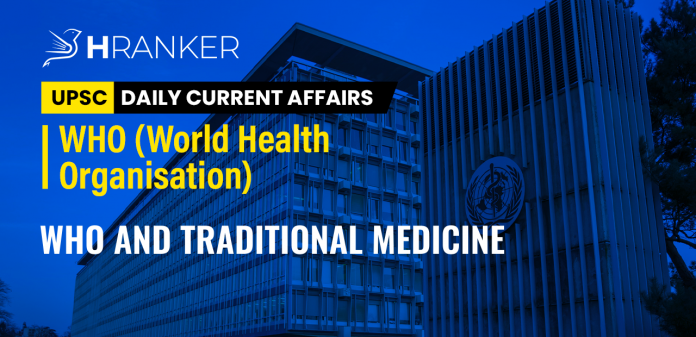WHAT’S IN NEWS:
PM Narendra Modi, along with World Health Organization (WHO) Director-general Dr. Tedros Ghebreyesus performed the ground-breaking ceremony for the first of its kind, WHO Global Centre for Traditional Medicines (GCTM) in Jamnagar, Gujarat; for enhancing wellness in society.
- Acupuncture: Acupuncture is a form of complementary therapy that involves inserting very thin needles into the body. Practitioners insert needles at different locations and depths to treat different health issues.
- Homeopathy: It is a medical system developed in Germany more than 200 years ago. Homeopathic products come from plants, minerals, or animals. It uses a different diagnostic system for assigning treatments to individuals and recognizes clinical patterns of signs and symptoms that are different from those of conventional medicine.
- Siddha: The Siddha system of medicine is mainly practised in the Southern part of India. It is one of the earliest traditional medicine systems in the world which treats not only the body but also the mind and the soul. The word Siddha has its origin in the Tamil word Siddhi which means “an object to be attained” or “perfection” or “heavenly bliss”. The roots of this system are intertwined with the culture of ancient Tamil civilization.
- Artificial Intelligence: Artificial intelligence (AI) refers to the simulation of human intelligence in machines that are programmed to think like humans and mimic their actions. The term may also be applied to any machine that exhibits traits associated with a human mind such as learning and problem-solving. For example: Self-driving Cars, Manufacturing Robots etc.
TRADITIONAL MEDICINE:
The WHO describes Traditional Medicine as the total sum of knowledge, skills and practices, indigenous or from different cultures that have been used over time to maintain health and prevent, diagnose and treat physical and mental illness. It encompasses ancient practices such as acupuncture, ayurvedic medicine and herbal mixtures as well as modern medicines.
In Indian context, it includes practices and therapies such as Yoga, Ayurveda, Siddha – that have been part of Indian tradition historically such as Homeopathy that have become part of Indian traditions over the years.
Traditional medicine – Prevalent in States
- Ayurveda and Yoga – Across the country
- Siddha – Tamil Nadu and Kerala
- Sowa – Rigpa – Leh, Ladakh, Sikkim, Arunachal Pradesh, Lahaul-spiti (Himalayan Region)
GLOBAL CENTRE FOR TRADITIONAL MEDICINE (GCTM):
- It was established in Jamnagar with the signing of a past country arrangement between the Government of India and the WHO with a support of $250 million from India for establishment, infrastructure and operations.
- It will focus on evidence based research, innovation and data analysis to optimise the contribution of traditional medicine to global health.
- It will support efforts to implement the WHO’s traditional medicine strategy (2014 – 2023) which aims to support nations in developing policies and strengthen the role of traditional medicine in pursuing the goal of universal health coverage.
GLOBAL SIGNIFICANCE OF TRADITIONAL MEDICINE:
- As per WHO estimates, 80% of the world’s population uses traditional medicines and 170 out of its 194 member states have reported the use of traditional medicines and these member states have asked for WHO’s support in creating a body of reliable evidence and data on traditional medicines practices and products.
- It will help conserve biodiversity and sustainability as about 40% approved pharma products are derived from natural substances such as:
Medicine Formulation
Aspirin Bark of willow tree
Contraceptive pills Roots of wild yam
Child cancer Rosy Periwinkle
- Ways to study traditional medicine are being modernised. Artificial Intelligence is used to map evidence and trends in traditional medicines. For example, functional MRI is being used to study brain activity and relaxation response to meditation and yoga.
CONCLUSION:
Even earlier, Government of India has signed various project collaborations with different countries, universities, institutes for using technology and innovation such as Artificial Intelligence to map traditional medicine trends, innovations and patents linking to WHO’s innovation hub such as an MOU between CSIR – Institute of Himalayan Bio-resource Technology, Palampur with National Research Institute of Chinese medicine, Taiwan for research on medical plants, bioactive molecules and herbal formulation etc.




